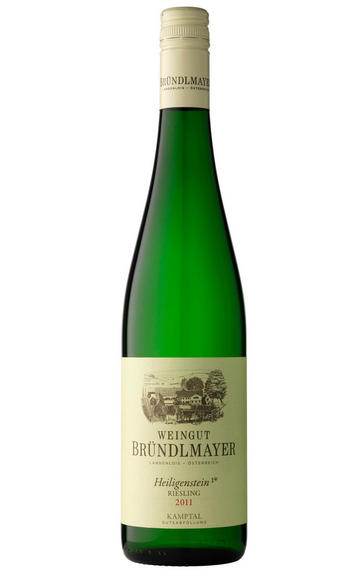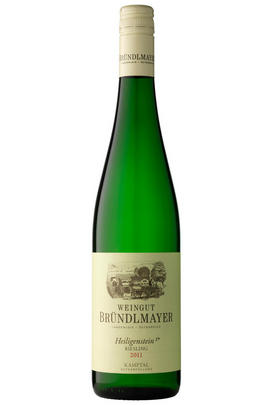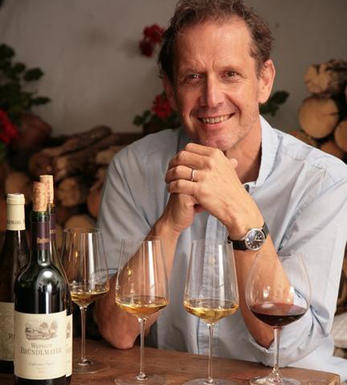
2011 Riesling, Zöbinger Heiligenstein, Erste Lage, Willi Bründlmayer, Kamptal, Austria

About this WINE

Willi Brundlmayer
Willi Bründlmayer is widely recognised as one of Austria's most gifted winemakers. He is best known for his Rieslings and Grüner Veltliners, although he also makes very high quality Chardonnays.
He has 57 hectares of vineyards, superbly sited high up on slopes around the wine town of Langenlois. His best site is the Heiligenstein vineyard where the rocky granite/slate soils produce Rieslings of astonishing mineral intensity, which age beautifully.

Riesling
Riesling's twin peaks are its intense perfume and its piercing crisp acidity which it manages to retain even at high ripeness levels.
In Germany, Riesling constitutes around 20% of total plantings, yet it is responsible for all its greatest wines. It is planted widely on well-drained, south-facing slate-rich slopes, with the greatest wines coming from the best slopes in the best villages. It produces delicate, racy, nervy and stylish wines that cover a wide spectrum of flavours from steely and bone dry with beautifully scented fruits of apples,apricots, and sometimes peaches, through to the exotically sweet flavours of the great sweet wines.
It is also an important variety in Alsace where it produces slightly earthier, weightier and fuller wines than in Germany. The dry Rieslings can be austere and steely with hints of honey while the Vendages Tardives and Sélection de Grains Nobles are some of the greatest sweet wines in the world.
It is thanks to the New World that Riesling is enjoying a marked renaissance. In Australia the grape has developed a formidable reputation, delivering lime-sherbet fireworks amid the continental climate of Clare Valley an hour's drive north of Adelaide, while Barossa's Eden Valley is cooler still, producing restrained stony lime examples from the elevated granitic landscape; Tasmania is fast becoming their third Riesling mine, combining cool temperatures with high UV levels to deliver stunning prototypes.
New Zealand shares a similar climate, with Riesling and Pinot Gris neck to neck in their bid to be the next big thing after Sauvignon Blanc; perfectly suited is the South Island's Central Otago, with its granitic soils and continental climate, and the pebbly Brightwater area near Nelson. While Australia's Rieslings tend to be full-bodied & dry, the Kiwis are more inclined to be lighter bodied, more ethereal and sometimes off-dry; Alsace plays Mosel if you like.


Buying options
Add to wishlist
Description
The Bründlmayer family owns 12 hectares right in the centre of the Zöbinger Heiligenstein. 10,5 hectares are planted with Riesling, the remainder for experimental purposes with Cabernet (mostly Cabernet Franc). About 20% of the vineyards are trained in the Lyra trellis system. The other Heiligenstein vines are raised by the traditional Guyot method with the berries hanging 50-60 centimeters above the ground. Thinning is done as required to restrict the average yield to 35/40hl per hectare for this classic (Kamptal DAC) Version. From a geological point of view the Zöbinger Heiligenstein site is not only the oldest but probably also the most interesting on our estate: the soil consists of approximately 270 Mio years old Perm desert sandstone.
The sediments contain volcanic inclusions and carbonized remains of primeval vegetation. The uniqueness of this soil, its perfect gradient and position (SW to SE in a climatic borderland) provide ideal preconditions for growing outstanding vines. During the day warm winds (often due to the effects of the Pannonian Climate) drift along the site whereas by nightfall cool gusts from the North start blowing through the Kamp Valley and bring forward the aromatic expression of the grapes.Late harvested healthy grapes are necessary for this classic Kamptal DAC style. The must is fermented in stainless steel at a temperature of 15-20° celsius.
After fermentation the wine was partly racked into big wooden casks to mature for a short period on the fine yeast. Excellent with freshly cut porcini, this bright, composed Riesling has the soft suave quality one associates with the best of Kamptal, underpinned by a neat sapidity; it rings with sunny comice pear prettiness.Drinking now but should improve over the next decade.
wine at a glance
Delivery and quality guarantee